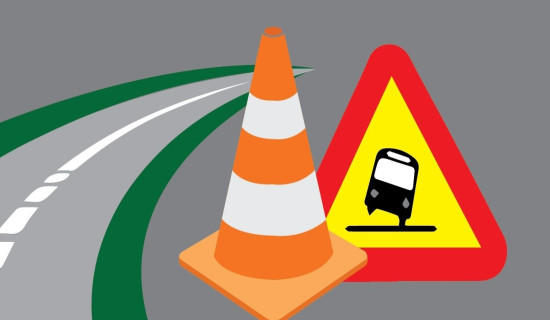- Monday, 15 December 2025
Toxic Culture of Fast Fashion
 The
mushrooming number of online fashion stores is the primary attraction for
many young teens and adults in Nepal these days. You open your Instagram and
there it is, you are bombarded with zillion such fashion stores. Every social
media offers you a high-quality picture of a dress, be it hanging over the
store or a young model flaunting the attire. Those pictures are bound to entice
you to grab your hands into them.
The
mushrooming number of online fashion stores is the primary attraction for
many young teens and adults in Nepal these days. You open your Instagram and
there it is, you are bombarded with zillion such fashion stores. Every social
media offers you a high-quality picture of a dress, be it hanging over the
store or a young model flaunting the attire. Those pictures are bound to entice
you to grab your hands into them.
But
little do we know, such actions are directly or indirectly fueling fast fashion
culture.
The word
‘fast fashion' describes how quickly retailers can make designs from the catwalk
to stores, keeping pace with constant demand for more and different styles.[i] Fast
fashion is fast in the sense that everything is changing rampantly. The trend is
changing fast, the rate of production is fast, and customers’ decision to purchase
is fast in fact even the delivery and payment are fast.
Fast
fashion’s concept emerged during the 1960s in Galicia, Spain. Inditex was the first
company known to have introduced fast fashion which changed the fate of the fashion
industry.[ii]
Inditex stands to be a holding company of many global fast fashion companies
like: Zara, Pull&Bear, and Bershka amongst others.[iii] The
growth of fast fashion does not seem to take any ease. In the year 2021 alone,
the fast fashion industry had a transaction of $91.23 billion.[iv] By
the end of 2022, this industry is expected to have achieved a compound growth
rate of 8.8%. Zara, H&M, Forever21, Shein, UNIQLO, UrbanOutfitters, GAP,
Topshop, Primark, Fashion Nova, and Newlook amongst others are the prime fast
fashion market players across the globe. The mushrooming number of fashion
stores today is nothing but a reflected intention of many stores and online
outlets to walk in the footsteps of these global moguls.
Although
financially and as a business strategy the footsteps of these global fast
fashion chains may appear appealing; but the carbon footprints such companies
leave behind, to environmental responsiveness and faint human rights diligence
is daunting to be inspired with. Many consumers of these global fashion brands
are aloof from the dreadful implication of such industries upon human rights
(particularly labor rights) and the environment.
As per
the report and methodological consideration carried out by Quantis
international, the fashion industry is solely responsible for one-third of all the
microplastics found in the ocean and over 20% of the global water waste. The fast fashion industry is largely responsible for creating a vast amount of textile
waste. More than 92 million tons of textiles per year (more than 85%) end up in landfill.[v] 8-10 % of the carbon emission
which acts as a blanket in the air, trapping heat in the atmosphere and warming
up the earth[vi] also comes from the fast fashion
industry. The global per capita textile production has increased to 13 kg in a
short span of 43 years. In the same vein, global consumption has risen to an
estimated 62 million tons of apparel every year. Fast fashion is projected to
increase thrice as much by 2030 and the burden upon the environment shall increase
accordingly.[vii]
Another
tragic side to fast fashion culture is unraveled from the unethical labor
practices. Fast fashion companies are known for taking their businesses in
developing countries such as; Vietnam, India and Bangladesh. By opening subsidiaries
in such countries, these million-dollar-making companies intend to reap the
most out of cheap labor and unregulated labor practices. The fast fashion industry
approximately employs [viii]75
million factory workers worldwide.[ix]
However, only less than 2% of them make a living wage.[x]
Laborers are exploited at a younger age with a below-the-belt minimum wage. The
killing of 1100 workers and injury of over 2500 of them in May 2013 of Rana
Plaza Building[xi], at Bangladesh is a
catastrophic instance of labor exploitation. H&Ms late response to end
shop-floor sexual violence in India and poor working conditions of many workers
in Shein’s main production base in China sheds light on unethical labor practices
ongoing in the fast fashion industry.
Nepal is
not aloof to fast fashion culture. Social media has become the primary catalyst
for the fast fashion industry in Nepal. It rigorously stems from the urge amongst many
Nepalese people to buy so-called ‘new-affordable’ clothes. Fast fashion has a
huge role to play in triggering the “I don’t repeat my clothes” attitude amongst
many. Supposed celebrities and influencers also have a huge role to play in
fueling this attitude. We are bombarded with numerous pictures and instances of
celebrities in a new attire in every social event, in every public appearance
and in every social media post they make but we barely see any celebrities
repeating their clothes or promoting sustainable fashion choices. Nonetheless,
Ricky Rej (two-time Grammy winner) wore the same outfit to the Cannes film festival
that he previously wore to Grammy earlier this year.[1] Ricky
Rej’s sartorial motto was to put out a strong message before the world:
“fashion can be trendy twice”. Influencers
and public figures must realize the power in their hands and use their sphere
of influence for good. Although some portion of the burden towards slowing down
the catastrophe of fast fashion falls upon public figures, the burden upon the
shoulders of consumers is no less. It is extremely essential to look at the
background, purpose cause, and impact of the brand any consumer is using or any
influencer is promoting.
On 5th
June 2022, the World observed the 49th World Environment Day. The theme for
2022 is ‘Only One Earth’. In order to act towards achieving the end of this
motto, we must understand the need to slowly discard fast fashion. As consumers
or as public figures one must mete out a balance between the ‘want and need’
whilst making our fashion choices. We must not overlook the labor exploitation
of workers, who work at the grass root level in order to serve the market with
the environmentally costly but supposedly ‘fast and affordable’ clothing we
prefer to wear.
It is
never too late to switch to sustainable fashion. Options such as thrifting,
re-wearing, buying less and assessing the longevity of what we buy can have a
huge impact on reducing carbon footprints and textile waste. Renowned
Fashion Designer, Vivienne Westwood quotes, ‘Buy less, choose well and make
it last’. This definitely can be a mantra towards discarding the toxic culture
of fast fashion and marching toward sustainability.
(Author
is a final year law student at Kathmandu School of Law)
[1] Pranita Chaubey, ‘Cannes 2022: Why two time Grammy winner
Ricky Rej repeated his outfit at the film festival’, NDTV Movies, 18 May
2022; https://www.ndtv.com/entertainment/cannes-2022-why-two-time-grammy-winner-ricky-kej-repeated-his-outfit-at-the-film-festival-2988360
[i] Rachel Bick
et al, ‘The global environmental injustice of fast fashion’, Environmental
Health, Volume 17, Issue 92, 2018; https://www.researchgate.net/publication/329938899_The_global_environmental_injustice_of_fast_fashion
[ii] Alex
Crumbie, ‘What is fast fashion and why is it a problem?’, https://www.ethicalconsumer.org/fashion-clothing/what-fast-fashion-why-it-problem,
5 October 2021;
[iii] Luis G
Dopico et al, ‘Zara-Inditex and growth of fast fashion’, Essays in Economic
and Business History, January 2007; https://www.ebhsoc.org/journal/index.php/ebhs/article/view/181
[iv] Kirsi
Niinimaki et al, ‘The environmental price of fast fashion’, Nature Review, Volume
1, April 2020; https://finix.aalto.fi/wp-content/uploads/2021/04/Nature_review_Niinimaki-2020.pdf
[vi] Khozema Ahmed Ali et al, ‘Issues,
impacts and mitigation of carbon-dioxide emissions in building sector’, mdpi,
August 2020; https://www.mdpi.com/2071-1050/12/18/7427
[ix] Emma Ross,
‘fast fashion getting faster: a look at the unethical labor practices
sustaining a growing industry’, International Law and Policy Brief, 28
October 2021; https://studentbriefs.law.gwu.edu/ilpb/2021/10/28/fast-fashion-getting-faster-a-look-at-the-unethical-labor-practices-sustaining-a-growing-industry/
















